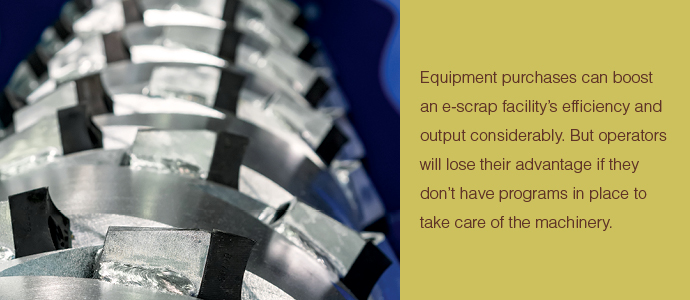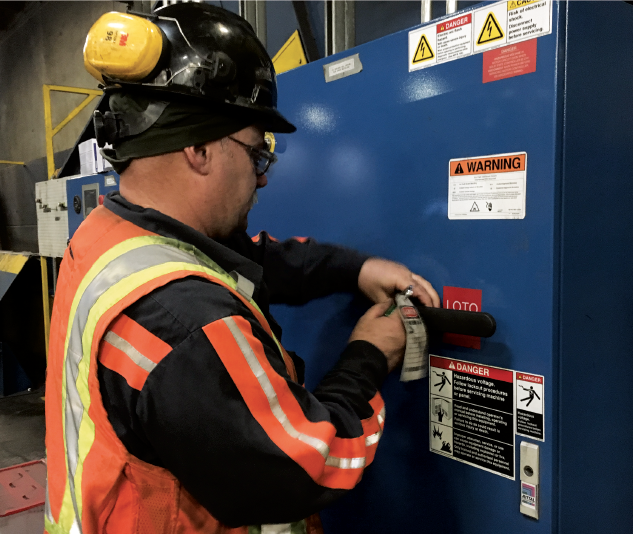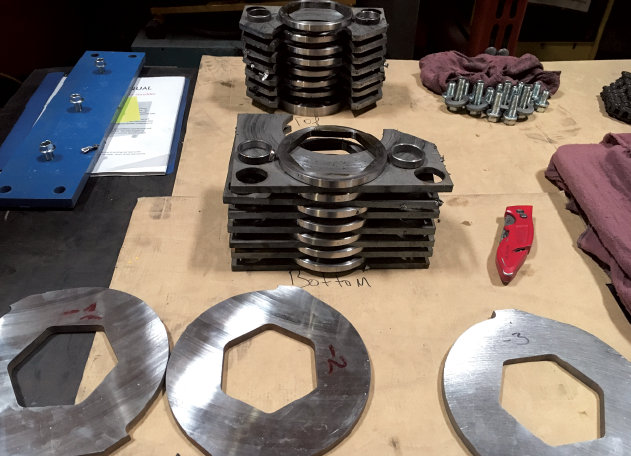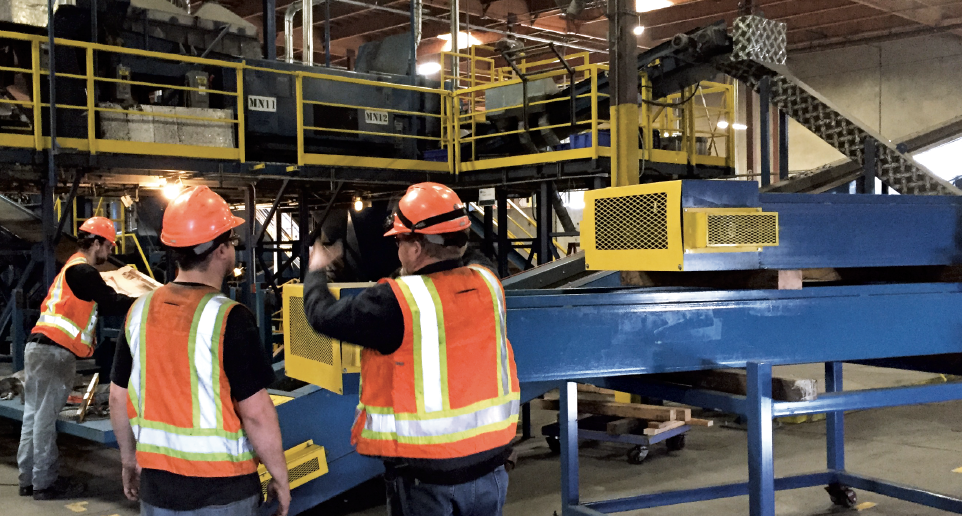
This article originally appeared in the Fall 2019 issue of E-Scrap News. Subscribe today for access to all print content.
Effective maintenance programs often elude owners of new shredding lines and heavy equipment. Installation of these projects is difficult and by the time the line is running and producing, oil changes and factory-prescribed maintenance may not be top of mind.
Many may even delay scheduled preventative maintenance inspections to meet a production goal or special run. Low unemployment and a lack of trained technicians are other barriers that prevent high-performing preventative maintenance programs.
This article will lay out steps to address these potential stumbling blocks, showing why maintenance programs should be reframed as investments that have clear payback.
Values: Getting away from ‘good enough’
The first step on the journey to excellence is to decide what level of management commitment will be applied to the machine assets. Is maintenance a core organizational value and aligned with the business needs? Is the goal to have zero failures?
Pinpoint the level of resources that will be committed to maintaining the equipment. The commitment might include hiring a professional staff at the right numbers, keeping them trained, purchasing critical spares, and paying for diagnostic services, such as oil analysis and vibration monitoring.
You need properly qualified maintenance professionals undertaking this work, and not surprisingly, a higher caliber technician will cost more than someone with less experience. Many tasks can be taught, but that takes time as opposed to having a professional ready to go.

Machine specialists can be contracted to regularly check for early signs of equipment failure.
Further, having an adequate number of technicians on the team is important to ensure there are no disruptions to plant operations. In some circumstances, maintenance work can be outsourced, particularly for heavy vehicles, forklifts and other relatively common machines.
Making sure the team has the right tools also pays dividends. This allows employees to work more efficiently while also indicating a deeper level of support from management. When you buy workers the right impact gun or socket set as opposed to bargain buys from box stores, you are helping them handle their tasks safer and with more ease.
Next, budgets for spare parts should be reviewed and either built in upfront to the capital purchase or turned into a regular monthly budget line item. Viewing spare parts as a percentage of the equipment cost is useful. In general, operators can assume they will spend 10-15 percent of the asset purchase price on spare parts, depending on the machine.
For non-domestic equipment, a higher percentage is worth considering if lead times are longer for orders. Also consider building in a budget for specialized diagnostic services. These include specialists that analyze for signs of early machine failure in oil samples and investigate vibration data from critical bearings on expensive or key equipment. Another consideration may be the use of infrared cameras to scan electrical switchgear for signs of loose connections.
Other providers may use industrial internet of things (IIoT) approaches to plug in your machine to the cloud, and provide valuable insights into performance or potential failures.
In developing your maintenance values, creating metrics is a prerequisite. Measuring the effectiveness of the program over time is key to assessing the return on investment of your maintenance spend. Simple items such as uptime, number of unplanned failures and the inspection-completion rate are easy metrics to track and generally make sense to the whole plant.
Processes: How much and when?
Now it’s time to look at the equipment user’s manual and study it as a basis for developing your inspection checklists.
Use care that the unit of time is hour-based for your schedule and the machinery has an hour meter. Each machine will generally have multiple inspection routines that vary in severity of tasks and complexity, much like a car has simple oil changes and spark plug replacements at different intervals.
Referencing the manufacturer’s recommendations is a good starting point, but conditional changes are sometimes needed. For example, a shredder processing heavy scrap may need synthetic oil in the gear reducers, and may need replacement twice as often. Or, a hydraulic heat exchanger in a dusty area may need to be cleaned out more frequently. While tedious, developing procedures (including photos and diagrams) on how to undertake different interval inspections on the equipment will help a maintenance program achieve consistency and better quality.

By developing a plan and budget for spare parts, an operator can reduce downtime and have a clearer picture of ROI.
Specify how the completed work will be documented and filed – examples include a work-order system or use of a computerized maintenance management software. This is also an opportunity to clearly articulate safe work procedures (for instance, how to replace a conveyor belt, change a belt lacing or track the conveyor).
As a reminder, it is compulsory as prescribed by the Occupational Safety and Health Administration (OSHA) to have specific lock-out-tag-out procedures for each piece of equipment. All procedures and inspections should include an initial time target to enable the scheduling process. Time goals should be determined as a group effort with those assigned to the work.
The next step in developing the program is scheduling. If done properly, this will increase the chances for maintenance program success. The classic tug-of-war is always between the maintenance and production teams, and that tension is typically a symptom of poor planning.
Since the duration of the inspections is known, time blocks can be assigned to them and they can often be grouped together based on physical proximity or similarity of tasks. For example, one half-hour maintenance segment slated every day may cover 80 percent of the prescribed inspections and the remaining 20 percent can be done Friday afternoon after the last shift.
It is sometimes possible to shift work schedules and have production teams start after maintenance to reduce production interruptions further. The true test of the plant’s system of values will come when a production goal needs to be met at the cost of deferring maintenance. Will extra efforts be taken to make up for the missed inspections and get the schedule back on track, or will maintenance just be skipped? Consider posting the schedule so it is public and becomes part of the plant cadence.
Optimization: Perfecting the program
The holy grail of maintenance programs is to reach a situation where minimum time is spent and maximum uptime is achieved, and this can be achieved in many small steps over time. Start with holding a regular review of the maintenance inspection lists for each asset and integrate the technician’s feedback, adjusting the frequency and list of tasks as needed.
For example, a certain conveyor may need to be inspected for tail-pulley debris buildup more often, but it might not require bearing greasing as frequently. Compare these changes to uptime and unplanned failure instances and look for trends and the effect of the changes.
The practice of “kitting” is a low-cost and effective way to speed up maintenance tasks. A kit with all the parts, consumables and tools is assembled well ahead of the scheduled inspection, task or part replacement. For example, a sorting machine up high on a platform may have a small toolbox permanently placed with the exact wrenches needed to do a belt swap, or a shredder may have the air tools and sockets for cutter rotations stationed next to the machine.
For a more elaborate job, such as a cutter change on a shear shredder, specialized tools and prep are more significant. By doing some prior assembly, the time to do the task might be cut down drastically. Every trip and interruption adds up, so assembling a kit down to the smallest detail can be helpful.
Now that you have increased efficiency, it’s time to focus on moving the team through training. Training not only boosts morale and tells the employees you care; it also speeds up execution. You’ll need to identify which programs make sense for which workers: One technician may be a good fit to send to an electrical controls class, another may benefit from a trip to the machine manufacturer’s facility for a class on a specific type of equipment.
Most manufacturers are very agreeable to training and can offer your team deep insights into the ideal way to work with their products. Safety training is also mission critical and may cover areas such as electrical safety, lifting and rigging, working at heights, and confined spaces.

As a maintenance program matures, it’s smart to have team members from another department audit the system to review how often inspections are taking place, parts inventory and other facets.
Integrating a computerized maintenance management system (CMMS) can take an established maintenance team and program to the next level. Losing the paper and having access to real-time information from the cloud enables better analysis and faster response.
Using the technology, it becomes easier to see the work-order history, costs and trends on each asset, making it clear what’s working and what isn’t. Service requests from other teams can be seamless and allow for better descriptions of the problem.
These CMMS systems often have an advanced scheduling function to optimize planning and create alerts when a critical task is due. Metrics are often automated and can be displayed in real-time for the whole plant to see. Some of the better programs also manage parts inventory and procedures, so a simple tablet can interface and display what the technician needs.
Sustainability: Getting stronger over time
Much like the 5S programs used in lean manufacturing (sort, set in order, shine, standardize and sustain), an audit function with metrics helps to keep a maintenance program relevant and effective. As equipment ages, issues increase in complexity and the maintenance program must evolve to keep the plant-reliability metrics at the agreed upon target.
Have a team member from another plant or department undertake the audit and review items such as inspection-completion rate, tool organization, procedures, training records, parts-inventory accuracy, machine guarding and overall machine condition. A scoring system should be applied, and different teams can set goals for how they do each time. Scores might even be compared on a league table, creating some healthy competition.
A fast and efficient team can stumble if workers do not have the right spare parts. After the first six months, there should be enough experience to undertake a failure mode effect analysis (FMEA). This is essentially a detailed study of every way an asset can fail.
For the case of a simple conveyor, failures can include a bad gearmotor, contactor, e-stop relay, ripped belt, seized bearing, bad lacing or faulty pulley shaft caused by a seized bearing. The team then ranks each failure on likeliness, the time required to source the parts and overall plant downtime that would occur in the event of failure. This can be an enlightening exercise and drive certain spares to be kept on the shelf or others to be stored in a vendor’s inventory instead.
Some suppliers will agree to stock certain parts for customers, helping on inventory spend. However, parts kept on the supplier’s shelf could also become obsolete (or might not be available when needed). FMEAs should be completed at regular intervals for the best effect, since vendors and plant conditions can change.
Emerging technologies using IIoT systems are quickly becoming mainstream and can take an established maintenance program to a higher level of real-time, condition-based monitoring for initiating work. Some examples include a small sensor with a magnetic base that can be placed on an electric motor to monitor vibration and temperature. Oil monitoring systems are available to monitor particulate levels, viscosity and moisture for the ideal time to replace oil.
More advanced systems can integrate with the machine’s programmable logic controller (PLC) and monitor the state of all inputs and outputs to look for trends in the metadata and allow for monitoring of motor load, weights processed or micro interruptions. These systems are becoming less expensive and the first place to start is typically with the equipment manufacturer.
Ultimately, maintaining equipment comes down to nurturing the right behaviors and making them habits. At the same time, investing in the right talent and tools distinguishes between mediocre and great teams.
Maintenance should be seen as a core value (as opposed to an afterthought) for organizations that want to improve their asset performance. By framing this topic correctly, operators will see clear upticks in uptime and dollars.
Brian Sanchez is the U.S. engineering manager for Sims Recycling Solutions, a leading global IT asset disposition (ITAD) and electronics recycling company. Find more information at simsrecycling.com.

